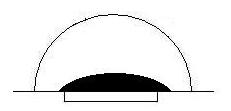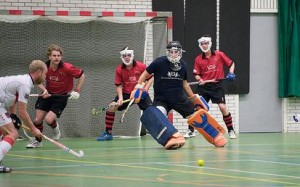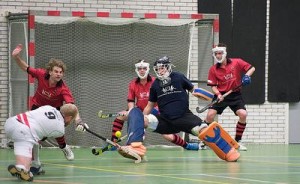When faced with a pass, the opposition is looking to shoot around you; moving the ball to expose and opening up gaps in the goal to shoot into. This is difficult for the goalkeeper, as they have to immediately change direction and try to get across as quickly as possible to make the save on the scoring opportunity. By playing deeper, you can cut off the intended shot; reducing the space and making it easier it get across in time to block, with less ground to cover.
The back door
In effect, the back door is the space left open by the goalkeeper as they challenge the initial shot; an outlet pass will leave the goalkeeper vulnerable to the space left open on the angle they have set up to make the save. By dragging you out of position, the opposition stand a chance of beating you easily, getting you to challenge too far out, and then ‘hanging you out to dry’, with a pass-shoot transition.
An aggressive goalkeeper who likes to challenge the angles is especially vulnerable to the back door pass, where a pass across the face of the goal would leave him open to the space on the side, left because of his aggressive positioning. By staying back against the play, as a lot of reflexive and reactive goalkeepers do, it is easier to react to the back door pass, diving across to make the stop.
How to react properly
The best way to react is to stay deeper in the net than normal, making it easier to react to the shot as it is fired, rather than trying to challenge the initial shot, which will leave you open to the pass and back door goal. By staying deeper and moving with the play and using reflexes, or diving across, you stand a greater chance of making the save. Let them do the work; don’t fall into their hands as they try to score on you.
Playing on the back line
Playing on the back line is a technique you will see top level goalkeepers using regularly (and something soccer goalkeepers also do); they are more passive and reflex styled to deal with a shot rather than trying to close down or tackle the ball carrier. Staying back against the shot, and deep within their box, they are more able to deal with a passed shot; able to reach across on the save, rather than get caught leaving open space by challenging the angle too far against the player with the ball.
When staying deep within your goal, you can either stay just off the goal line (where you can then run along the line to cover space), or use a much smaller ‘D within the D’; moving around a semi-circle reduced to meet the incoming shot off the pass.
With less distance to move to meet the shot, it also gives you a greater chance of making the save, as you have less to do to react; giving you more advantage. If the shot is straight off the pass, like a slap hit, then you have less time to react.
Moving into save
As the pass is made, you can react to the play, moving across to cover the available space and get set for a save. You should be able to follow the direction of the ball; cutting across by running horizontally, or going diagonally in order to challenge the shooter’s angle and cut down the available shooting space to limit their chances. A good shuffle across laterally should bring you into the ball’s path; moving along the goal line ready to block.
Making the save
The way you make the save depends on the type of shot you face. If you can, standing allows you to cover both high and low, filling up a lot of goal; if you do try to extend with your leg/arm to reach into the save. However, you may have jump or reach out for the save if you have little time to meet the ball. Diving will help you get more reach on the save, especially if the shot is low; pushing out in full extension to meet the ball on the shot, but be ready to get back up again immediately afterwards for further shots.
Pointers:
- stay deep in the D, close to the goal line
- be patient; wait for the pass
- once the pass has been made, move quickly across to meet the shot
- try to get behind the ball as much as possible to block
- if the ball is out of reach don’t be afraid to dive and extend into the save





Very informative, sir.
mmm. Gd Article. However I think there is a third option you’re overlooking which I find to be quite successful.
Instead of either staying back or rushing out to charge down a non existant shot, come off your line, narrow the angle for intial shot, but stay on your feet, most strickers will then look to pass, at which point you can dive in and cut it off. If you get close enough to the ball carrier you can dive around him in an L-shape, (pads for the shot, hands for the ball). Giving you a gd chance of cutting off the shot and intercepting the pass.
I prefer this option in two on ones like this, at least you are controlling the situation rather than being reactive and wait for them to rooof it from 3 yards. In the prefered situation you outline I fear you won’t have much chance for a well struck shot.
Floz.
I try to deal with these situations a bit like an icehockey goalie.
I don’t really rush out of my goal but move a few steps towards the attacker who has the ball. When he’s in like 3 meters distance from me I start moving backwards, forcing the attacker to make a move. I found this method to be quite succesful on most ocassions. Most attackers don’t know, how to react on this behaviour and while they’re considering their move, I just stop moving and go for the ball. This way the element of surprise is helping me, which I think is quite good.
If the attacker tries to make a pass, I just get my stick on the ball (even if it results in a short corner).
If the attacker tries to get past me, I just throw myself into his way… 😉